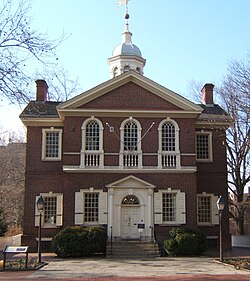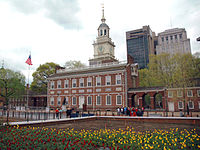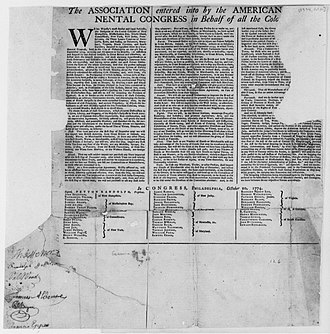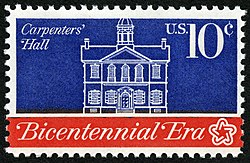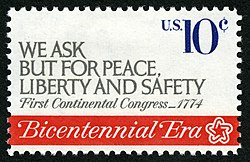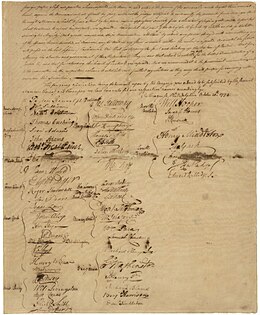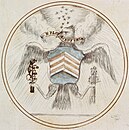First Continental Congress
| ||||||||||||||||||||||||||||||||||||||||||||||||||||||||||||
Read other articles:
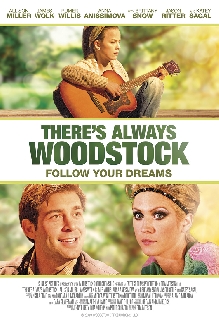
This article does not cite any sources. Please help improve this article by adding citations to reliable sources. Unsourced material may be challenged and removed.Find sources: There's Always Woodstock – news · newspapers · books · scholar · JSTOR (July 2014) (Learn how and when to remove this message) 2014 American filmThere's Always WoodstockDirected byRita MersonWritten byRita MersonProduced byPeter SchaferStarring Allison Miller Jason Ritter Brittany …

Флаг гордости бисексуалов Бисексуальность Сексуальные ориентации Бисексуальность Пансексуальность Полисексуальность Моносексуальность Сексуальные идентичности Би-любопытство Гетерогибкость и гомогибкость Сексуальная текучесть Исследования Шка�…

U.S. Air Force award for airmanship James Jabara, Korean War AceThe Jabara Award for Airmanship, named in memory of Colonel James Jabara (1923-1966), is awarded each year to the United States Air Force Academy graduate whose accomplishments demonstrate superior performance in fields directly involved with aerospace vehicles. With 15 kills, Colonel Jabara was the second leading Air Force ace of the Korean War. Colonel Jabara was the First American Jet Ace. Each year the U.S. Air Force Academy and…

This article has multiple issues. Please help improve it or discuss these issues on the talk page. (Learn how and when to remove these template messages) This article needs additional citations for verification. Please help improve this article by adding citations to reliable sources. Unsourced material may be challenged and removed.Find sources: Moto G9 – news · newspapers · books · scholar · JSTOR (November 2020) (Learn how and when to remove this messa…

American AristocracyFilm daringSutradaraLloyd IngrahamCeritaAnita LoosPemeranDouglas FairbanksJewel CarmenSinematograferVictor FlemingPerusahaanproduksiFine Arts Film CompanyDistributorTriangle Film CorporationTanggal rilis 12 November 1916 (1916-11-12) Durasi52 menitNegaraAmerika SerikatBahasaBisuIntertitel Inggris American Aristocracy adalah sebuah film komedi-drama/petualangan bisu Amerika Serikat tahun 1916 garapan Lloyd Ingraham dan menampilkan Douglas Fairbanks. Sebuah cetakan 35mm da…
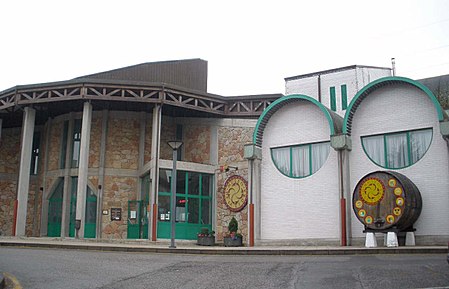
Museum in Nava, Asturias, Spain For the museum in England, see Cider Museum, Hereford. Cider Museum (Museo de la Sidra)Established1996LocationPlaza del Príncipe de AsturiasNava, Asturias, SpainWebsitehttp://www.museodelasidra.com/index2.htm The Cider Museum (Spanish: Museo de la Sidra) is located in the Plaza del Príncipe de Asturias in Nava, Asturias, Spain. Opened in 1996 by Prince Philip,[1] it is a themed museum that showcases Asturian national drink, cider. The museum is a member …

U.S. state This article is about the U.S. state. For other uses, see South Dakota (disambiguation). State in the United StatesSouth Dakota Dakȟóta itókaga (Lakota)StateState of South Dakota FlagSealNickname: The Mount Rushmore State (official)Motto: Under God the People RuleAnthem: Hail, South Dakota!Map of the United States with South Dakota highlightedCountryUnited StatesBefore statehoodDakota TerritoryAdmitted to the UnionNovember 2, 1889 (40th)CapitalPierreLargest citySioux…

نوكيا آشا 306معلومات عامةالنوع هاتف محمول الصانع نوكياعائلة المنتج تاتش مكتملالوظائفالشاشة 240 × 400الكاميرا - الخلفية:2 ميجابكسلالإدخال شاشة لمس متعددالخصائصنظام التشغيل سيريز 40القياساتالوزن 96 غرامالإصداراتالسلسلة نوكيا آشا تعديل - تعديل مصدري - تعديل ويكي بيانات نوكيا آشا 3…

الحب والثمن الحب والثمن الصنف دراما تاريخ الصدور 26 أكتوبر 1970 مدة العرض 100 دقيقة البلد مصر اللغة الأصلية العربية الطاقم المخرج عبد الرحمن الخميسي الإنتاج الفنية للسينما قصة عبد الرحمن الخميسي سيناريو وحوار علي الشوباشيإبراهيم الموجي البطولة أحمد مظهرزيزي البدراويإب�…

Proposed railway line in Hong Kong North Island line北港島綫OverviewOwnerMTR CorporationLocaleDistricts: Central and Western, Wan Chai, EasternTerminiNorth PointHong KongStations4ServiceSystemMTROperator(s)MTR CorporationTechnicalTrack gauge1,432 mm (4 ft 8+3⁄8 in) Route map Legend Colour legend New tracks (Tung Chung line) New tracks (Tseung Kwan O line) InterchangeSwap Names of two schemes Island lineto Kennedy Town Tung Chung lineto Tung Chun…

This article is about the art form that uses paper. For the art form that uses porcupine quills, see Quillwork kertas quilling Singa 3D Quilling atau filigree kertas adalah seni menggunakan kertas yang digulung, dibentuk, dan direkatkan bersama untuk membuat desain dekoratif. Kertas tersebut digulung, dilingkarkan, dilengkungkan, dipelintir dan dimanipulasi untuk menciptakan bentuk guna menghias kartu ucapan, gambar, kotak, telur, dan untuk membuat model, perhiasan, ponsel, dan sebagainya. Sekar…

Peta menunjukan lokasi Tanauan Tanauan adalah munisipalitas yang terletak di provinsi Leyte, Filipina. Pada tahun 2010, munisipalitas ini memiliki populasi sebesar 49.310 jiwa atau 9.862 rumah tangga. Pembagian wilayah Secara administratif Tanauan terbagi atas 54 barangay, yaitu: Ada Amanluran Arado Atipolo Balud Bangon Bantagan Baras Binolo Binongto-an Bislig Cabalagnan Cabarasan Guti Cabonga-an Cabuynan Cahumayhumayan Calogcog Calsadahay Camire Canbalisara Catigbian Catmon Cogon Guindag-an Gui…

Traditional clothing of the indigenous peoples of Arctic North America Women's traditional caribou skin outfit with amauti parka, trousers, mitts and long boots with side pouches. The back of the parka has an amaut or pouch for carrying a baby. From Baker Lake, Eskimo Point and Hikoligjuaq, west of Hudson Bay. Collected on 5th Thule Expedition, 1921–1924 Modern women's parka created by Inuk designer Victoria Kakuktinniq, 2021. The body of the parka is made from synthetic waterproof fabric, wit…

South African professional wrestler Parts of this article (those related to All Elite Wrestling) need to be updated. The reason given is: Only has up to 2019 at present. Please help update this article to reflect recent events or newly available information. (February 2023) AngélicoAngélico in November 2015Birth nameAdam BridleBorn (1987-05-07) 7 May 1987 (age 37)Johannesburg, Transvaal,South AfricaProfessional wrestling careerRing name(s)Adam Angel[1]Adam BridleAdam CroftAngélic…

Large computer systems produced by IBM since 1952 History of IBM mainframes, 1952–present Market name 700/7000 series 1400 series System/360 System/370 30XX series (303X, 308X, 3090) System/390 eServer zSeries (900, 800; 990, 890) System z9 System z10 zEnterprise System (z196, zEC12) IBM Z (z13, z14, z15, z16) Architecture System/360 System/370 S/370-XA ESA/370 ESA/390 z/Architecture vte IBM mainframes are large computer systems produced by IBM since 1952. During the 1960s and 1970s, IBM domin…

French writer, playwright and composer Alexandrine-Sophie de Bawr, 1810, by Louis-Léopold Boilly Baroness Sophie de Bawr (8 October 1773 – 31 December 1860), born Alexandrine-Sophie Goury de Champgrand, was a French writer, playwright and composer, also known as Comtesse de Saint-Simon, Baronne de Bawr, and M. François. Life She was born in Paris, the illegitimate daughter of Marquis Charles-Jean de Champgrand and opera singer Madeline-Virginie Vian. Her godmother was Madeleine-Sophie Arnoul…

FimosisBerkas:Fimosis.jpgPenis dengan gejala fimosis.Informasi umumSpesialisasiUrologi Setelah operasi sunat Fimosis, dari bahasa Yunani phimos (φῑμός, 'moncong'), merupakan kondisi penis yang kulupnya tidak dapat ditarik seluruhnya melewati kepala penis. Istilah ini juga dapat merujuk pada fimosis klitoral pada perempuan, yaitu kondisi klitoris yang selubungnya tidak dapat ditarik sehingga membatasi paparan ujung klitoris.[1] Saat lahir, kulup menyatu dengan kepala penis dan…

1937 film A Diplomatic WifeDirected byCarl BoeseMieczysław KrawiczWritten byBobby E. LüthgeKonrad TomStarringJadwiga KendaAleksander ŻabczyńskiLena ŻelichowskaMieczysława ĆwiklińskaCinematographyHenryk VlassakMusic byMichael JaryProductioncompaniesNerthus FilmPolski TobisDistributed byTobis FilmRelease date 28 March 1937 (1937-03-28) CountriesGermanyPolandLanguagePolish A Diplomatic Wife (Polish: Dyplomatyczna żona) is a 1937 German-Polish comedy film directed by Carl Boe…

The double-swing model (also known as the Möbius integration philosophy) is a model of intercultural communication, originated by Muneo Yoshikawa, conceptualizing how individuals, cultures, and intercultural notions can meet in constructive ways. The communication is understood as an infinite process where both parties change in the course of the communicative or translational exchange. Overview Yoshikawa highlights four major ways of handling the crossing of a cultural boundary:[1][…

Dutch cyclist (born 1991) Shanne BraspennincxBraspennincx in 2019Personal informationBorn (1991-05-18) 18 May 1991 (age 33)Turnhout, BelgiumTeam informationDisciplineTrack cyclingRider typeSprinter Medal record Women's track cycling Representing the Netherlands Olympic Games 2020 Tokyo Keirin World Championships 2015 Yvelines Keirin 2018 Apeldoorn Team sprint European Games 2019 Minsk Keirin 2019 Minsk Team sprint European Championships 2021 Grenchen Sprint 2021 Grenchen Team spr…

